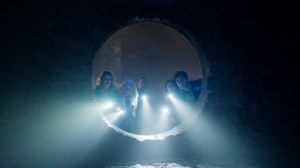John Carpenter is a director beloved by many. He has been behind some of the most iconic horror pictures of the past 50 years. Yet, despite his impressive track record, he remains something of an underdog. Several of his best films were box office bombs. Big Trouble in Little China and The Thing are widely beloved by fans (and critics), yet both underperformed at the box office. That trend continued into the ‘90s with his impressive meta horror effort, In the Mouth of Madness. The film made less than $9 million at the global box office (against an estimated budget of $8 million) before eventually turning a profit on home video.
Videos by ComicBook.com
Adding insult to injury, the flick failed to resonate with critics. In fact, In the Mouth of Madness isn’t even fresh on Rotten Tomatoes; the film holds a lackluster rating of just 59% on the platform.
In the Mouth of Madness is an imaginative flick that surprises and delights in equal measure. In crafting the story, screenwriter Michael De Luca takes ample inspiration from the works of celebrated author H.P. Lovecraft. The narrative follows insurance investigator John Trent (Sam Neill), who is hired to investigate the disappearance of bestselling author Sutter Cane (Jürgen Prochnow). With Sutter’s editor, Linda (Julie Carmen) in tow, John travels to the fictional New Hampshire town of Hobb’s End, where the author’s novels are set. On that fateful trek, fiction and reality collide in a number of mind-melting ways, leading John to question his perception of reality.
In the Mouth of Madness Is a Standout Meta Horror Effort That Deserves Far More Critical Acclaim

It’s a shame that the collective critical reaction to In the Mouth of Madness has been decidedly lukewarm. Some film scholars posited that the narrative is a bit messy, but that feels very much like an unfair criticism. The flick is meant to be unpredictable, surreal, and unhinged. The picture is very much designed to unfold like a bizarre fever dream from which you cannot wake. It’s deeply influenced by Lovecraft, after all. While the picture may not be everyone’s cup of tea, it seems rather unfair to fault the movie for staying faithful to its influences.
Even if you take issue with the oft-unhinged narrative, you have to give the film credit for leaning into metatextual horror in a mind-melting fashion that pulls the audience in and makes them feel very much like a part of the proceedings. We won’t say too much more than that, as it’s nearly impossible to discuss this particular aspect in detail without giving away some of the twists that await the uninitiated.
Another standout aspect is Sam Neill’s impressive showing as John. Neill turns in a textured performance that allows him to show off his dynamic range. He gives the viewer a front-row seat to his gradual descent into utter madness without going so far over the top that he loses the viewer in the process.
Neill’s impressive central showing is nicely complemented by Carpenter’s direction. The beloved filmmaker crafts palpable tension and establishes an eerie and unsettling atmosphere. Fans of the film appreciate the way that he opts to rely more heavily on a persistent baseline of unease than cheap jump scares.
In addition to a great central showing from a talented lead and deft direction by Carpenter, the flick also features dynamite practical effects work courtesy of the legends at KNB EFX Group. Naturally, the impressive creature design featured within even includes a tentacled monster that nods to the film’s Lovecraftian influences.
All in all, In the Mouth of Madness is an impressive John Carpenter picture that, like many of his other works, took time to find its audience. Though the film eventually connected with horror fans, it remains sorely underrated by critics. That’s a crying shame, seeing as this is a flick that makes effective use of meta horror, features a strong showing from a capable lead, and delivers truly exceptional practical effects crafted by legendary artists.
How about you, dear reader? Did you connect with everything this 1994 Lovecraftian horror picture gets right? Or do you side with critics in your assessment? We’d love to hear what you think. Step up to the comments section below and let us know your take.









